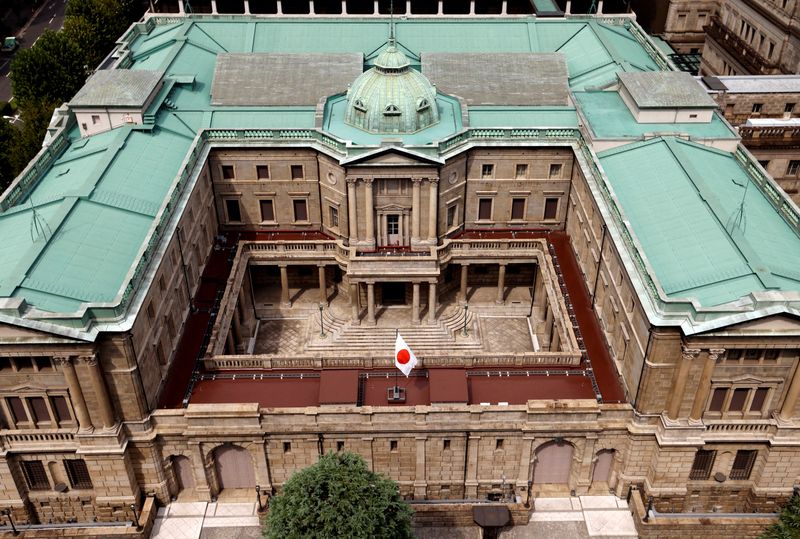Research-BOJ’s hawkish rhetoric alerts likelihood unfavourable charges might finish quickly By means of Reuters
 © Reuters. FILE PHOTO: Eastern nationwide flag is hoisted atop the headquarters of Financial institution of Japan in Tokyo, Japan September 20, 2023. REUTERS/Issei Kato/Report Picture
© Reuters. FILE PHOTO: Eastern nationwide flag is hoisted atop the headquarters of Financial institution of Japan in Tokyo, Japan September 20, 2023. REUTERS/Issei Kato/Report PictureBy means of Leika Kihara
TOKYO (Reuters) – The Financial institution of Japan has stepped up its drum beat of hawkish feedback during the last week, in a sequence of communications that insiders say is priming markets for an finish to unfavourable rates of interest, which might occur within the first few months of subsequent yr.
The distinct alternate in BOJ observation is part of Governor Kazuo Ueda’s plan to dismantle the arguable financial stimulus of his dovish predecessor Haruhiko Kuroda, which has been blamed for a number of problems together with the yen’s sharp declines.
The hawkish tilt follows the BOJ’s determination closing month to chill out its cap on long-term charges by means of tweaking its yield curve keep an eye on (YCC) coverage and contrasts with the rhetoric of Ueda in a while after he took the helm this yr, which gave the impression to name for a continuation of Kuroda-era stimulus.
Ueda closing week mentioned Japan used to be making development in sustainably hitting the BOJ’s 2% inflation goal, and that it may not essentially wait till actual wages flip certain in phasing out stimulus. 3 resources aware of the financial institution’s pondering say the shift to a much less dovish tone used to be intentional.
“The governor’s feedback on inflation had been steadily converting during the last few months, which provide an excellent steer at the BOJ’s coverage route,” some of the resources mentioned.
“The BOJ is most likely in a section now the place it is in search of the correct timing to boost rates of interest,” every other supply mentioned, a view echoed by means of a 3rd supply.
Ueda’s efforts to transport Japan clear of the extraordinarily accommodative financial settings of the section decade are sophisticated by means of dangers that doing so too briefly may harm a delicate financial restoration and cause large marketplace upheaval.
On the other hand, with inflation proceeding to overshoot the BOJ’s 2% goal, the commercial justification for a shift is steadily construction.
Having watered down YCC at its closing coverage assembly, the BOJ’s subsequent purpose is to drag momentary charges out of unfavourable territory early subsequent yr, resources have instructed Reuters.
REASONS FOR CHANGE
The BOJ has mentioned subsequent yr’s spring salary talks between trade and unions shall be key to the timing of an go out. Many giant companies in most cases settle pay round mid-March, which heightens the danger of a coverage alternate in April.
However the BOJ does no longer essentially want to look forward to salary talks to conclude to tweak coverage, so long as sustained fulfillment of its worth purpose may also be foreseen, the resources say.
The financial institution’s nine-member board could also be tilting extra hawkish with some calling for the want to get started phasing out large stimulus and keep in touch the danger of a long term go out from ultra-low charges, a abstract of critiques at their October assembly confirmed.
“It is herbal to suppose the BOJ is beginning to lay the groundwork for normalising coverage,” mentioned Mari Iwashita, leader marketplace economist at Daiwa Securities and a veteran BOJ watcher.
Extra imminently, different knowledge issues for coverage deliberations may come from the financial institution’s “tankan” trade sentiment survey due on Dec. 13, a meeting of BOJ regional department managers in early January, and feedback from trade and union executives on subsequent yr’s pay targets.
That leaves open the danger of an coverage alternate in January, when the BOJ subsequent critiques its quarterly worth forecasts.
“It is actually a question of conviction and simple task. In spite of everything, it is a judgment name,” some of the resources mentioned.
Just about 60% of economists polled by means of suppose tank Japan Heart for Financial Analysis after the October coverage tweak be expecting the BOJ to tighten coverage in April, adopted by means of 12% projecting a January transfer. Maximum be expecting an finish to each YCC and unfavourable charges.
LONG ROAD
The BOJ’s newest worth projections launched in October display inflation is predicted to stay stubbornly above the financial institution’s goal within the fiscal yr finishing March 2024, casting doubt on its view that contemporary cost-driven worth rises are brief.
Its present projection for “core-core” inflation, which strips away recent meals and gasoline, is at 3.8%, up a hefty two share issues from the January estimate.
“It is an extraordinarily giant improve and presentations how the BOJ had made estimates that have been manner too low,” mentioned former BOJ most sensible economist Hideo Hayakawa, who expects unfavourable charges to finish in April.
There are many dangers that would impede an early go out, corresponding to a U.S. recession. Ueda will have to additionally steer clear of drawing warmth from reflationist-minded lawmakers.
However the BOJ can’t come up with the money for to attend too lengthy. Despite the fact that it ends unfavourable charges, nominal momentary borrowing prices will stay smartly underneath ranges that neither stimulate nor cool the financial system – estimated by means of analysts to face someplace close to 2%.
“Ueda’s function is to eliminate the radical insurance policies of his predecessor, and revert to a coverage concentrated on momentary charges,” mentioned former BOJ board member Takahide Kiuchi. “That is a challenge he wishes to perform right through his five-year time period.”






